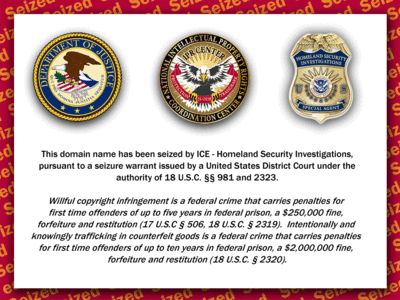With the same made-for PR timing that prompted a previous seizure of domain names just before shopping’s “Cyber Monday,” Immigration and Customs Enforcement struck again, this time days before the Super Bowl, against “10 websites that illegally streamed live sporting telecasts and pay-per-view events over the Internet.” ICE executed seizure warrants against the 10, ATDHE.NET, CHANNELSURFING.NET, HQ-STREAMS.COM, HQSTREAMS.NET, FIRSTROW.NET, ILEMI.COM, IILEMI.COM, IILEMII.COM, ROJADIRECTA.ORG and ROJADIRECTA.COM, by demanding that registries redirect nameserver requests for the domains to 74.81.170.110, where a colorful “This domain name has been seized by ICE” graphic is displayed.

As in a previous round of seizures, these warrants were issued ex parte, without the participation of the owners of the domain names or the websites operating there. And, as in the previous rounds, there are questions about the propriety of the shutdowns. One of the sites whose domain was seized was Spanish site rojadirecta.com / rojadirecta.org, a linking site that had previously defeated copyright infringement claims in Madrid, its home jurisdiction. There, it prevailed on arguments that it did not host infringing material, but provided links to software and streams elsewhere on the Internet. Senator Ron Wyden has questioned the seizures, saying he “worr[ies] that domain name seizures could function as a means for end-running the normal legal process in order to target websites that may prevail in full court.”
According to ICE, the domains were subject to civil forfeiture under 18 U.S.C. § 2323(a), for “for illegally distributing copyrighted sporting events,” and seizure under § 981. That raises procedural problems, however: when the magistrate gets the request for seizure warrant, he or she hears only one side — the prosecutor’s. Without any opposing counsel, the judge is unlikely to learn whether the accused sites are general-purpose search engines or hosting sites for user-posted material, or sites providing or encouraging infringement. (Google, for example, has gotten many complaints from the NFL requesting the removal of links — should their domains be seized too?)
Now I don’t want to judge one way or the other based on limited evidence. Chilling Effects has DMCA takedown demands from several parties demanding that Google remove from its search index pages on some of these sites — complaints that are themselves one-side’s allegation of infringement.
What I’d like to see instead is due process for the accused before domain names are seized and sites disrupted. I’d like to know that the magistrate judge saw an accurate affidavit, and reviewed it with enough expertise to distinguish the location of complained-of material and the responsibility the site’s owners bear for it: the difference between direct, contributory, vicarious, and inducement of copyright infringement (for any of which a site-owner might be held liable, in appropriate circumstances) and innocent or protected activity. As Joe Hall has written here, domain names can’t defend themselves.
In the best case, the accused gets evidence of the case against him or her and the opportunity to challenge it. We tend to believe that the adversarial process, judgment after argument between the parties with the most direct interests in the matter, best and most fairly approaches the truth. These seizures, however, are conducted ex parte, with only the government agent presenting evidence supporting a seizure warrant. (We might ask why: a domain name cannot disappear or flee the jurisdiction if the accused is notified — the companies running the .com, .net, and .org registries where these were seized have shown no inclination to move or disregard US court orders, while if the name stops resolving, that’s the same resolution ICE seeks by force.)
If seizures must be made on ex parte affidavits, the magistrate judges should feel free to question the affiants and the evidence presented to them and to call upon experts or amici to brief the issues. In their review, magistrates should beware that a misfired seizure can cause irreparable injury to lawfully operating site-operators, innovators, and independent artists using sites for authorized promotion of their own materials.
I’d like to compile a set of public recommendations to the magistrate judges who might be confronted with these search warrants in the future, if ICE’s “Operation In Our Sites” continues. This would include verifying that the alleged infringements are the intended purpose of the domain name use, not merely a small proportion of a lawful general-use site.
